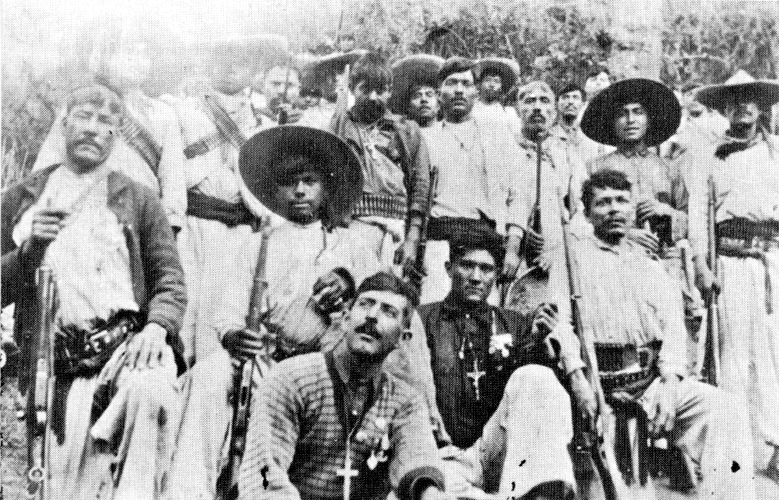 |
| Cristero Revolt |
Between 1926 and 1929 a localized uprising exploded in Mexico's western states in reaction to the anti-Catholic policies of Mexican president Plutarco Calles, which attacked the privileged position of the Catholic Church.
Many Mexican revolutionaries viewed the church as the enemy and worked toward stripping it of its political power and landholdings. The writers of the constitution of 1917 sought to tip the balance of power by weakening the church and subordinating it to a strong Mexican state through a variety of provisions. The constitution prohibited the church from owning property and barred clergy members from voting, holding political office, or assembling for political purposes.
Calles enforced these constitutional provisions with anticlerical legislation that forbade the wearing of religious clothing in public, placed all primary education under state control, required the registration of clergy, allowed state governors to reduce the number of practicing ecclesiastics, and called for the deportation of foreign-born clerics. In reaction Mexican priests suspended their religious duties in July 1926, refusing to hold Mass, hear confessions, or administer the sacraments.
  |
The attack on the Catholic Church enshrined in the constitution of 1917 had aroused considerable interest and action from many Mexicans. A few priests and several lay leaders encouraged direct action. One group to heed that call was the National League for the Defense of Religious Liberty (LNDLR), a civic organization that formed in May 1925.
Responding to the religious strike by the clergy, the LNDLR called on Mexican Catholics to rise up in arms against the Calles government in the name of Christ and as defenders of the faith. The rebels, dubbed Cristeros due to their battle cry, "Vivo Cristo Rey," or "Long Live Christ the King," targeted schools in particular, the new symbol of the revolutionary regime in rural Mexico. They burned several to the ground and murdered teachers.
Calles's administration listed national education as a priority and viewed the building of 2,000 rural schools as a success; rural residents resented the schools, which placed financial and land burdens on poor communities and challenged traditional Catholic norms.
Full-blown rebellion exploded when Catholic insurgents bombed a government troop train. Sporadic unorganized guerrilla warfare characterized most of the violence, with local leaders recruiting a dozen to a hundred horsemen as a mounted fighting force, supported by groups of peasants serving as the infantry.
Few of the leaders had military experience. The LNDLR attempted to direct the rebellion and create national cohesion among the Cristeros, but its members lacked knowledge of military tactics and command.
The group named a journalist living in the United States, René Capistrán Garza, as the head of the Catholic revolution. Garza never assumed military command of the rebellion and worked unsuccessfully toward gaining the support of U.S. Catholics against the anticlericalism of the Mexican government.
Conversely, many of the rebel leaders in the field simply ignored the leadership of the LNDLR or were disenchanted with the organization's inabilities to send supplies or reinforcements. Although many Cristeros fought courageously and mounted a significant challenge to the federal army, in the end they did little to threaten the stability of the Calles government.
The diplomatic work of U.S. ambassador Dwight Morrow brought the Cristero rebellion to an end. Morrow worked diligently to convince Calles to create peace in Mexico with the Catholic Church, and in 1929 negotiations between the government and the church resulted in a truce.
The church agreed to operate within the law and resumed services, but it would never again command the prominent place in Mexican social and political life it had enjoyed for over two centuries. Although a minority of Catholics participated in the rebellion and it was centered in the western states of Jalisco, Michoacán, Oaxaca, Zacatecas, and Colima, by the end of the violence over 50,000 Mexicans had died, and many others had fled the country.